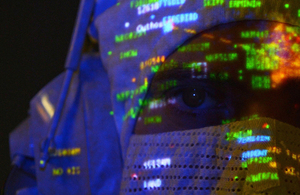Dstl AI tracks global radar systems
Using Artificial Intelligence (AI), scientists at the Defence Science and Technology Laboratory (Dstl) are shining a light on enemy radars by using a world-leading radar tracking system to help protect UK military personnel and their equipment during operations around the world.

A radar operator in the operations room onboard a Type 23 frigate HMS Monmouth
Thousands of radars exist globally, many of which are being used by hostile nations to track and potentially threaten UK military operations. Getting accurate, real-time information on these radars is extremely problematic, time-consuming and costly, in addition to the risk of leaving our Armed Forces operating with limited information.
Dstl’s Moonlight system uses machine-learning algorithms to gather vital data. It is the only system of its kind which automatically updates the position of more than 10,000 radars every day using machine learning thereby saving 32,000 hours of manual analytical effort each month. The data gathered is now helping to improve planning and post event analysis of UK supported joint maritime, land and air missions.
Dstl’s Alasdair Gilchrist, said:
A key part of our role at Dstl is making sure we protect our people and the platforms they work within. This novel software improves the MOD’s knowledge of radar threats, making sure we have safer operations for all of our Armed Forces. It significantly enhances operational effectiveness saves the user time and money.
Dstl has worked with industry partners 3SDL Ltd to tackle the problem. The new and novel machine-learning software has been developed to automate the process, which allows much greater accuracy on the location and identifies radars in near real time.
Jamie Thomas, a Warrant Officer with the Royal Navy, said:
Moonlight provides a mission critical input into the UK’s maritime operational picture at the Maritime Operations Centre. Moonlight data is fused with other sources to provide situational awareness as well indications and warnings to deployed frontline units. This is critical to support the decision-making process and is key to providing success on operations on a daily basis.
The United States, Canada, Australia and New Zealand have all expressed an interest in using Moonlight. Dstl is now designing a version for NATO, which will greatly improve the Alliance’s ability to identify and locate threat radars.